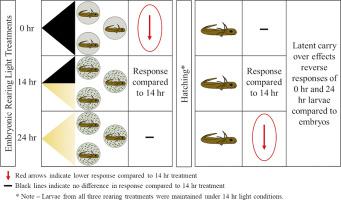当前位置:
X-MOL 学术
›
Comp. Biochem. Physiol. A Mol. Integr. Physiol.
›
论文详情
Our official English website, www.x-mol.net, welcomes your feedback! (Note: you will need to create a separate account there.)
Physiological benefits and latent effects of an algal-salamander symbiosis.
Comparative Biochemistry and Physiology A: Molecular & Integrative Physiology ( IF 2.3 ) Pub Date : 2020-04-19 , DOI: 10.1016/j.cbpa.2020.110715 Daniel P Small 1 , Cory D Bishop 2
Comparative Biochemistry and Physiology A: Molecular & Integrative Physiology ( IF 2.3 ) Pub Date : 2020-04-19 , DOI: 10.1016/j.cbpa.2020.110715 Daniel P Small 1 , Cory D Bishop 2
Affiliation

|
Embryos of the salamander Ambystoma maculatum (Shaw) and the uni-cellular green alga Oophila amblystomatis (Lambert ex Wille) have evolved a resource exchange mutualism. Whereas some of the benefits of the symbiosis to embryos are known, the physiological limitations of the relationship to embryos and carry over or latent effects on larvae are not. To determine the impact of the relationship across life history stages, we measured the growth, survival, and metabolic rate in response to hypoxia of salamander embryos reared under 0-h light (algae absent), 14-h light (control - algae present, fluctuating light conditions) and 24-h light (algae present, chronic light conditions) and the resulting larvae two-weeks post hatch. Embryos reared under 0-h light demonstrated decreased growth and survival compared to 14- and 24-h light, with no effect on metabolic rates or the response of metabolic rates to declining oxygen partial pressure (pO2). Conversely, larvae from embryos reared under 0-h light exhibited compensatory growth during the two-week larval rearing period, with body sizes matching those from the 14-h light treatment. Larvae from embryos reared under 24-h light had lower wet body mass and LT50 values upon starvation compared to those reared under 14-h light. Coupled with the lowest metabolic rates under normoxic pO2 levels, this indicates the presence of negative latent effects. We discuss the findings in relation to the effect of the symbiotic relationship on hypoxia tolerance and larval fitness with respect to the presence of compensatory growth and negative latent effects.
中文翻译:

藻类-蜥蜴共生的生理益处和潜在影响。
the(Ambystoma maculatum)(Shaw)和单细胞绿藻Oophila amblystomatis(Lambert ex Wille)的胚胎已经发展了资源交换的共生关系。尽管共生对胚胎有一些好处,但与胚胎的关系以及对幼虫的延续或潜在影响的生理局限性尚不明确。为了确定这种关系在生活史各个阶段的影响,我们测量了在0小时光照(藻类缺失),14小时光照(对照-存在藻类)下饲养的sal胚胎缺氧时的生长,存活和代谢率光照条件波动)和24小时光照(存在藻类,长期光照条件)以及孵化后两周产生的幼虫。与14小时和24小时光照相比,在0小时光照下饲养的胚胎显示出生长和存活率下降,对代谢率或代谢率对氧分压(pO2)下降的响应没有影响。相反,在两小时的幼体饲养期中,在0h光照下饲养的胚胎的幼虫表现出补偿性生长,其体型与14h光照处理的个体相匹配。与在14小时光照下饲养的胚胎相比,在24小时光照下饲养的胚胎的幼虫在饥饿时具有较低的湿体重和LT50值。再加上在常氧性pO2水平下最低的代谢率,这表明存在潜在的负面影响。我们讨论关于代偿性生长和负潜伏效应的共生关系对低氧耐受性和幼虫适应性的影响的发现。相反,在两小时的幼体饲养期中,在0h光照下饲养的胚胎的幼虫表现出补偿性生长,其体型与14h光照处理的个体相匹配。与在14小时光照下饲养的胚胎相比,在24小时光照下饲养的胚胎的幼虫在饥饿时具有较低的湿体重和LT50值。再加上在常氧性pO2水平下最低的代谢率,这表明存在潜在的负面影响。我们讨论关于代偿性生长和负潜伏效应的共生关系对低氧耐受性和幼虫适应性的影响的发现。相反,在两小时的幼体饲养期中,在0h光照下饲养的胚胎的幼虫表现出补偿性生长,其体型与14h光照处理的个体相匹配。与在14小时光照下饲养的胚胎相比,在24小时光照下饲养的胚胎的幼虫在饥饿时具有较低的湿体重和LT50值。再加上在正常氧分压下的最低代谢率,这表明存在潜在的负面影响。我们讨论关于代偿性生长和负潜伏效应的共生关系对低氧耐受性和幼虫适应性的影响的发现。与在14小时光照下饲养的胚胎相比,在24小时光照下饲养的胚胎的幼虫在饥饿时具有较低的湿体重和LT50值。再加上在常氧性pO2水平下最低的代谢率,这表明存在潜在的负面影响。我们讨论关于代偿性生长和负潜伏效应的共生关系对低氧耐受性和幼虫适应性的影响的发现。与在14小时光照下饲养的胚胎相比,在24小时光照下饲养的胚胎的幼虫在饥饿时具有较低的湿体重和LT50值。再加上在常氧性pO2水平下最低的代谢率,这表明存在潜在的负面影响。我们讨论关于代偿性生长和负潜伏效应的共生关系对低氧耐受性和幼虫适应性的影响的发现。
更新日期:2020-04-19
中文翻译:

藻类-蜥蜴共生的生理益处和潜在影响。
the(Ambystoma maculatum)(Shaw)和单细胞绿藻Oophila amblystomatis(Lambert ex Wille)的胚胎已经发展了资源交换的共生关系。尽管共生对胚胎有一些好处,但与胚胎的关系以及对幼虫的延续或潜在影响的生理局限性尚不明确。为了确定这种关系在生活史各个阶段的影响,我们测量了在0小时光照(藻类缺失),14小时光照(对照-存在藻类)下饲养的sal胚胎缺氧时的生长,存活和代谢率光照条件波动)和24小时光照(存在藻类,长期光照条件)以及孵化后两周产生的幼虫。与14小时和24小时光照相比,在0小时光照下饲养的胚胎显示出生长和存活率下降,对代谢率或代谢率对氧分压(pO2)下降的响应没有影响。相反,在两小时的幼体饲养期中,在0h光照下饲养的胚胎的幼虫表现出补偿性生长,其体型与14h光照处理的个体相匹配。与在14小时光照下饲养的胚胎相比,在24小时光照下饲养的胚胎的幼虫在饥饿时具有较低的湿体重和LT50值。再加上在常氧性pO2水平下最低的代谢率,这表明存在潜在的负面影响。我们讨论关于代偿性生长和负潜伏效应的共生关系对低氧耐受性和幼虫适应性的影响的发现。相反,在两小时的幼体饲养期中,在0h光照下饲养的胚胎的幼虫表现出补偿性生长,其体型与14h光照处理的个体相匹配。与在14小时光照下饲养的胚胎相比,在24小时光照下饲养的胚胎的幼虫在饥饿时具有较低的湿体重和LT50值。再加上在常氧性pO2水平下最低的代谢率,这表明存在潜在的负面影响。我们讨论关于代偿性生长和负潜伏效应的共生关系对低氧耐受性和幼虫适应性的影响的发现。相反,在两小时的幼体饲养期中,在0h光照下饲养的胚胎的幼虫表现出补偿性生长,其体型与14h光照处理的个体相匹配。与在14小时光照下饲养的胚胎相比,在24小时光照下饲养的胚胎的幼虫在饥饿时具有较低的湿体重和LT50值。再加上在正常氧分压下的最低代谢率,这表明存在潜在的负面影响。我们讨论关于代偿性生长和负潜伏效应的共生关系对低氧耐受性和幼虫适应性的影响的发现。与在14小时光照下饲养的胚胎相比,在24小时光照下饲养的胚胎的幼虫在饥饿时具有较低的湿体重和LT50值。再加上在常氧性pO2水平下最低的代谢率,这表明存在潜在的负面影响。我们讨论关于代偿性生长和负潜伏效应的共生关系对低氧耐受性和幼虫适应性的影响的发现。与在14小时光照下饲养的胚胎相比,在24小时光照下饲养的胚胎的幼虫在饥饿时具有较低的湿体重和LT50值。再加上在常氧性pO2水平下最低的代谢率,这表明存在潜在的负面影响。我们讨论关于代偿性生长和负潜伏效应的共生关系对低氧耐受性和幼虫适应性的影响的发现。


























 京公网安备 11010802027423号
京公网安备 11010802027423号